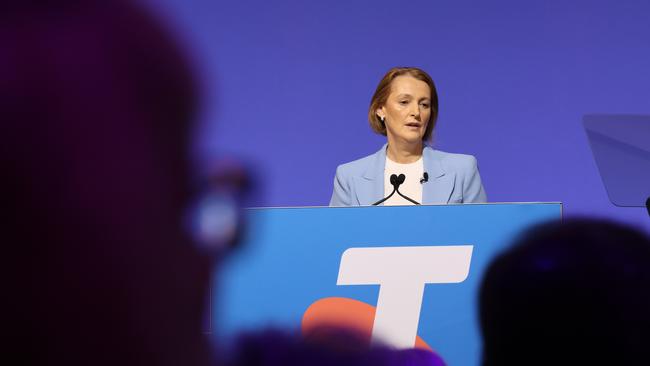Telstra must answer questions about no antenna needed mobile coverage claims
Australians deserve to know how reliable the nation’s biggest telco is and where it provides coverage to a regular mobile phone under normal use.

Business
Don't miss out on the headlines from Business. Followed categories will be added to My News.
Telstra appears to be laying the groundwork to refute any independent verification of its mobile coverage claims.
The problem for Australia’s biggest telco is that the accusation that it overstated its mobile network by about one million square kilometres is based on its own data.
On Monday this masthead reported that a $20m government audit of mobile coverage “contradicted” Telstra’s claim that an expensive external antenna wasn’t needed to access the entirety of its three million square kilometre network.
Accenture is performing the audit on behalf of the government – the same consulting firm that Telstra has entered a $700m joint venture with to accelerate digital transformation.
Telstra responded saying the audit was in its “early stages” and “started more than a year ago”.
“It’s only natural that there will be differences between its data, which is at a point in time, and mobile carrier coverage maps, which are constantly being updated”.
But Telstra’s own coverage maps, available on its website, showed mobile signals couldn’t be accessed without an antenna in the same areas the audit identified.
Still, chief executive Vicki Brady told investors on Tuesday that: “We have three million square kilometres of coverage and it doesn’t require an antenna”.
Telstra maintains that its network claims are “conservative” but then adds numerous caveats – such as coverage depends even on how people hold their phone – which seems nonsensical. But more on that later.

Ms Brady wrote in an opinion piece that there are areas within Telstra’s coverage area where “calls may drop out or can’t be made”. “Our customers know there are “black spots” and we know it too.”
So how many of these known “black spots” are there and why does Telstra include them in its coverage if its claims are “conservative”? This masthead has asked Telstra but is yet to receive an answer.
Late on Friday Telstra revealed how it tested its coverage. “We set a minimum dBm level that’s needed to maintain a good quality voice call. If the predicted signal strength is below this level, we exclude this area from our coverage footprint,” network boss Channa Seneviratne said.
Telstra has declined to say what that dBm – or decibels per milliwatt – level is, despite Ms Brady calling for a “consistent approach across the industry”. Optus and TPG have also asked what Telstra’s dBm setting is, so they can better compare coverage.
Why does this matter? Dbm is used to measure signal strength that mobile phones receive from cell towers. When a tower emits a signal, the strength of that signal weakens as it travels further away, and – to Telstra’s point about holding a phone – human bodies cause a signal loss of about 3dB.
Dbm is a logarithmic unit. The signal strength doubles with every third decibel. So if Telstra doesn’t include 3dB of body loss, when testing its coverage – for example it just places a phone on a metal stand – it is doubling the strength of the signal received.
Vodafone owner TPG raised concerns with Telstra about its coverage in April after it analysed network maps that Telstra provided to the ACCC.
Ms Brady said “we don’t know” how TPG calculated Telstra’s coverage but it was based on data that was “almost 18 months old” and “we have greatly increased the size of our 4G network since”.
Therefore, Telstra would have had to increase its outdoor mobile coverage from 1.9 million square kilometres - based on the data it provided to the ACCC last year - to three million. That’s an increase of more than 57 per cent (it may be less, given Telstra says it has previously been conservative).
The ACCC is assessing the allegations from TPG.
Nobody is doubting that Telstra has the biggest mobile network in Australia. It’s how big it is. Former competition tsar Allan Fels said Telstra’s scale has been a “considerable market attribute”.
And based on Telstra’s latest claim, you don’t need an antenna to drive between Hay to Ivanhoe and Cobar to Wilcannia in NSW, large sections of the Stuart Highway south of Coober Pedy, and between Yalgoo and Mount Magnet in Western Australia. These are all places Accenture, as part of the government’s $20m audit, identified as areas where Telstra coverage couldn’t be completely accessed with a normal mobile phone.
Australians deserve to know how reliable the nation’s biggest telco is and where it provides coverage to a regular mobile phone under normal use, particularly given there are alternatives – and not just from Optus or Vodafone.
Elon Musk’s Starlink can provide satellite mobile coverage across Australia from $80 a month in a package the size of a “backpack”.
Hopefully Telstra can answer the questions above.
More Coverage
Originally published as Telstra must answer questions about no antenna needed mobile coverage claims





